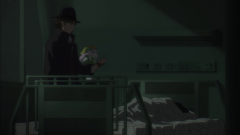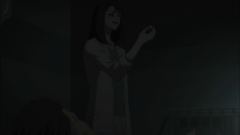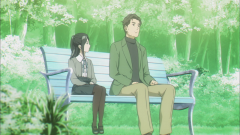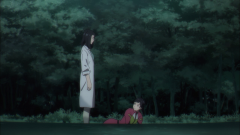This new arc of Boogiepop, “Boogiepop at Dawn”, serves as a prequel to the current timeline, and I’m glad to say that I consider this batch of episodes to be Boogiepop’s best arc so far. It addresses many issues that I have in previous arcs. For once, the length is just about right as it squeezes all the relevant characters to their full potential. Most of all, unlike “Vs Imaginator” where the main characters are hardly relevant, this arc Nagi is the beating heart as everything revolves around her and she’s the one crucial element that ripples the water. In addition to that, both Suiko and Miyashita appear at the right moments. I agree with what Animosh said in his comment about Miyashita, as of now we know very little about her, as a result we don’t find much to invest to her own character except when Boogiepop persona takes over. Secondly, the supporting cast’s purpose feel much stronger than any of previous arc. Everyone has their roles that further affect the tide of the current. Most importantly, however, Boogiepop at Dawn delivers some emotional affecting moments that it often lacks (usually deliberately so). Episode 10 for example is one of its most resonate episode because I can clearly feel the weight of suppressed emotions Scarecrow has paid his life for. It is something raw, powerful, and yet beautiful.
My praise doesn’t stop there, either. With this arc, I have a better grasp on the themes Boogiepop as a whole franchise wanted to address. It’s all about “evolution”, be it evolving to something that surpass humans physical ability, most at the cost of losing their own humanity (Dr Kisuki) and vice versa (in Scarecrow and Sasaki’s cases), or be it the transition from childhood to adulthood (in our main Miyashita character). It’s no surprise that the original light novels target young adult as its main audience, and like Suema asserted few episodes back this is the phase where teenagers go through some psychological changes, and these supernatural characters are a physical manifestation of these psychological changes. Myths and gossips give presence to these beings, and they take advantage or devoid the weak. Lastly, the character’s weight and their chemistry sink their teeth deeper on what lies between the lines, underneath the surface: The fact that Nagi never finds out that Sasaki was her father’s killer; the fact that we never witness what Pigeon has gone through after the death of Scarecrow but we all feel it through her course of action; or the fact that the only good deeds that Scarecrow did to save Nagi would be the catalyst for many catastrophe events happened in the future. I was thinking to myself how Nagi’d react to Sasaki if she learn the truth, and I came to the conclusion that it wouldn’t affect her decision at all. Nagi is just that strong and perceptive.
I’m certain we can draw a parallel between Scarecrow and Mo Murder arc, even though at first they function in the opposite spectrum. They are both artificial human, and they are well aware of that fact (in hindsight it’s neat to show how well they blend in to the society – we don’t know about Scarecrow being an artificial human until the end of episode 10). The crack of the surface appears when Scarecrow befriends a then bed-sicken Nagi with an incurable disease. It’s her words that give him the courage of becoming Superhero: helping others even at the cost of his life. This tender moment where he meets (and names) Boogiepop before he dies really hit it home. And it comes off as rather bittersweet to know that this action causes a massive butterfly effects to the all the events later on. This arc does a nice job of depicting artificial human with their own heart in contrast with humanity who lost their own nature. Mo Murder character serves as a nice addition as well. Though he’s a hired murderer, he does try to protect Nagi out of the mess and pays his life doing so.
On the other side of the coin, Dr. Kisuki steps as a formidable villain for this arc. She’s the kind of character who obsessed with “fear” feeling to the point the feeling consumes her. The more fear her victims experience the more bloodthirsty she becomes, and by utilizing the drugs that Scarecrows used to save Nagi, she evolves into a monster. I’m in awe how her character fits very well with Boogiepop’s evolution theme and it plays as a nice contrast to Scarecrow, Echoes and the likes. The other smaller characters also fulfill their roles nicely. Chief among them are Nagi’s father who catches on with all this, and Pigeon shines in a little screen time she has. She’s definitely an unsung hero for this arc. For a character that appears so little she’s surprisingly poignant and heartbreaking. I’m not sure what the next arc of Boogiepop gonna be like (if I have to guess, I’d say it’s an arc about Miyoshita the character), I just hope that it’ll be as good as this one. Up until now, I’m more curious with Boogiepop meandering, fragment approach than its theme or actual characters’ engagement, but Boogiepop at Dawn proves that it still has its chops to become something more than just its presentation.




